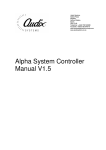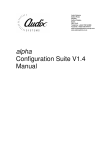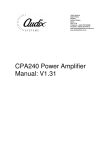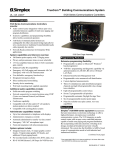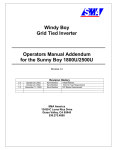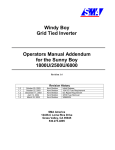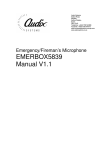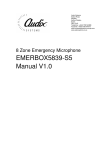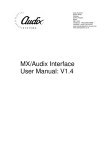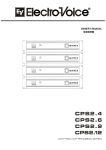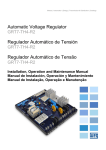Download MVPA / VPA Amplifier Manual V1.1
Transcript
MVPA/VPA Amplifier User Manual Audix Systems, Station Road, Wenden, Saffron Walden, Essex, CB11 4LG. Telephone: +44(0)1799 540888 Facsimile: +44(0)1799 541618 www.tycosafetyproducts-europe.com www.audixsystems.co.uk MVPA / VPA Amplifier Manual V1.1 Page 1 of 11 21015 V1.1 MVPA/VPA Amplifier User Manual Revision History Versio Modifications 1.0 1.1 Date Initial Draft Revised 09/07/2001 18/06/2002 © Copyright Audix Systems. 2005 DISCLAIMER This manual contains information that is correct to the best of Audix Systems knowledge. It is intended to be a guide and should be used as such. It should not be considered as a sole source of technical instruction, replacing good technical judgement, since all possible situations cannot be anticipated. If there are any doubts as to exact installation, configuration and/or use, call Audix Systems at +44 (0)1799 540888 ACKNOWLEDGEMENTS All trademarks are recognised Technical Support In the unlikely event of you having problems with your Amplifier please contact our Customer Services Department. Audix Systems Station Road Wenden Saffron Walden CB11 4LG Tel 01799 540888 Fax 01799 541618 Page 1 of 11 21015 V1.1 MVPA/VPA Amplifier User Manual CONTENTS REVISION HISTORY.................................................................................................................... 1 TECHNICAL SUPPORT ............................................................................................................... 1 1. SPECIFICATION............................................................................................ 3 1.1 1.2 1.3 1.4 1.5 1.6 2. SAFETY CONSIDERATIONS................................................................................... 9 2.1 2.2 2.3 2.4 3 AMPLIFIER MODEL RANGE .............................................................. 4 AMPLIFIER INTRODUCTION .............................................................. 4 AMPLIFIER SLEEP MODE ................................................................. 5 AMPLIFIERS CHASSIS FRONT PANEL DISPLAYS .................... 5 AMPLIFIER ADJUSTMENTS / LINK SETTINGS ........................... 5 AMPLIFIER PANEL ARRANGEMENT (MVPA1202)................. 8 Safety Considerations for System Maintenance.................................... 9 Electrical Hazards ..................................................................................... 9 Heat Hazards. .......................................................................................... 10 Weight Hazards. ...................................................................................... 10 MAINTENANCE ...................................................................................................... 10 Page 2 of 11 21015 V1.1 MVPA/VPA Amplifier User Manual 1. Specification Power Requirements (AC / DC) Amplifier chassis voltage requirements AC inrush current (Chassis fitted with 4 x 60 Watt PowerBlocs) 1 x 60 Watt RMS PowerBloc 2 x 60 Watt RMS PowerBloc 3 x 60 Watt RMS PowerBloc 4 x 60 Watt RMS PowerBloc Power Factor Heat Dissipation (Watts) 240 Watt Amplifier (Full Power) 240 Watt Amplifier (Half Power) th 240 Watt Amplifier (1/8 Power) Automatic thermal shutdown Audio / Electrical Characteristics Input Impedance Input Sensitivity Power Bandwidth (-3dB) Distortion (THD) Noise Fault Monitoring Built in monitoring circuitry (Fitted in MVPA models only) Short circuit protection Mechanical Dimensions (HxWxD) Audio connections Mains connections DC supply connections Amplifier Finish Reliability / Maintainability MTBF (hours) MTTR (i.e. fit replacement amp bloc) Environment Operating temperature range ( C) Relative Humidity 230 volts AC 50/60Hz with automatic reversion to 24VDC during AC failure 10A maximum for less than 1 second, non repetitive (typically <7.5A) 160VAC / 6.5ADC Max 320VAC / 13ADC Max 480VAC / 19.5ADC Max 640VAC / 26ADC Max 0.85 at maximum power 325 Watts 300 Watts 175 Watts Gain reduction while heatsink exceeds 85 C 10K ohms nominal, electronically balanced 0dBu (775mV) for rated power 100Hz – 20Khz Less than 1% at rated power, typically less than 0.08% at 1Khz. -80dB max Detection and display of individual PowerBloc Fail, Mains Fail, Battery Fail and Charger Fail. With general fault output to Monitoring System (FMS). Indefinite operation into short cct load 133 (3U) x 483 x 310 (rack mount 19”frame) Plug-in connectors with screw terminals I.E.C. mains connector 4-pin multiway connector Black 90,000 hours 15 minutes -5 C to 40 C 0 – 95% Page 3 of 11 21015 V1.1 MVPA/VPA Amplifier User Manual 1.1 Amplifier Model Range Audix Systems Model No. Output Channel s Weight MVPA601 MVPA602 MVPA603 MVPA604 MVPA1201 1 x 60W 2 x 60W 3 x 60W 4 x 60W 1x 120W 2x 120W 1x 120W 1 x 60W 1x 120W 2 x 60W 1x 180W 1x 180W 1 x 60W 1x 240W MVPA1202 MVPA1260 MVPA1262 MVPA1801 MVPA1860 MVPA2401 1.2 230AC (mA) Quiescen t 57 64 71 78 60 24VDC (A) Max. 230VAC (A) Max. 10Kg 12Kg 14Kg 16Kg 12Kg 24VDC (mA) Quiescen t 130 200 270 340 145 6.5 13 20 26 13 0.7 1.4 2 2.78 1.4 16Kg 230 70 26 2.78 14Kg 215 67 20 2 16Kg 285 74 26 2.78 14Kg 160 63 20 2 16Kg 230 70 26 2.78 16Kg 175 66 26 2.78 Amplifier Introduction Audix Systems 60 watt 'PowerBloc' amplifier modules are used individually or combined to provide 100 Volt line outputs of 60, 120, 180 or 240 Watts R.M.S. A rack mounting chassis/power supply occupying 3U of space holds up to four PowerBloc modules which may be arranged as four totally independent 60 watt amplifiers or in any of ten other output configurations (see paragraph 1.2 ‘Amplifier model range’ for details). Using proven MOSFET circuit techniques results in an efficient and extremely reliable power amplifier. The amplifiers are protected from short circuit speaker lines by current limiting on the output stage. The amplifiers are protected from persistently being over-driven by a thermal cut-out which is triggered at 85°C decreasing the amplifier input drive to reduce the output stage power dissipation. Modules operating in parallel share a single input/driver stage. Input level controls may be fitted to all combinations of PowerBlocs as appropriate. The output power of existing units can be increased at any time by the addition of more PowerBloc output modules (subject to available space in the mainframe). Page 4 of 11 21015 V1.1 MVPA/VPA Amplifier User Manual 1.3 Amplifier Sleep Mode While the system is idle all amplifiers are automatically set in ‘sleep’ mode to reduce power consumption. This is particularly important while the AC mains supply has failed and the system is running on internal batteries. In order to allow the 20Khz surveillance signal through the system, the control matrix feeds a ‘wake-up’ signal to all power amplifiers. The purpose of this signal is to command Audix MOSFET PowerBlocs to switch from their very low power consumption mode (asleep) to their quiescent state (awake). This allows the surveillance tone to pass through amplifiers without missing the first part of the signal. During normal speech announcements or alarms only the amplifiers selected for broadcast wake-up. In this case the wake-up is initiated by the audio at the input terminals of each amplifier. This ensures that any amplifiers NOT being used for broadcast remain in ‘sleep’ mode. 1.4 Amplifiers chassis Front Panel Displays Faults can be detected and displayed on ‘MVPA’ versions of the amplifier. 1.5 Amplifier Adjustments / Link Settings A maximum of 4 PowerBlocs can be fitted inside a chassis. A 240W unit is fitted with 4 PowerBlocs, one of which is a master (MPB260), while three are slave units (MPB261). The link settings on Master / Slave Blocs are as follows: Note: All adjustments are factory set. No further adjustments should be necessary. MPB160 Master VR1 VR2 - Fine Gain Control Quiescent Current MPB161 Slave Page 5 of 11 21015 V1.1 MVPA/VPA Amplifier User Manual VR1 VR2 - Not fitted Quiescent Current Front panel mounted lockable gain adjustment controls can be fitted (optional) to each Master PowerBloc. This allows user adjustment of audio levels, during system commissioning, which can be locked once set. Page 6 of 11 21015 V1.1 MVPA/VPA Amplifier User Manual Link Settings for MPB260 & 261 J1 wake- - Master / Slave. This 2 way jumper allows the Master Bloc to J2 Lk1 - up other associated slave Blocs in the same chassis. When fitted the audio input causes the amplifier to wake-up When not fitted the amplifier is permanently awake Monitor Board D678 Link Settings intervals J1 - If fitted the sample rate changes from 30 to 4 seconds (This link is temporarily fitted during PCB testing. All PCB’s are J2 J3 J4 J5 CHG BATT - factory set at 30 seconds) Jumper not fitted if amplifier fitted in slot position 1 Jumper not fitted if amplifier fitted in slot position 2 Jumper not fitted if amplifier fitted in slot position 3 Jumper not fitted if amplifier fitted in slot position 4 Fitted if system includes a battery charger Fitted if system includes back-up batteries Important Note: The current amplifier PowerBloc range is MPB260 (Master) and MPB261 (Slave). Older versions include 160, 161, 60 and 61. When fitting PowerBlocs into existing power / frames ensure that different versions are NOT mixed. I.E. 260 units should only be mixed with 261 units and 160 units should only be mixed with 161 units etc. Page 7 of 11 21015 V1.1 MVPA/VPA Amplifier User Manual 1.6 Amplifier Panel Arrangement (MVPA1202) AUDIX SYSTEMS Ω Ω Page 8 of 11 21015 V1.1 MVPA/VPA Amplifier User Manual 2. SAFETY CONSIDERATIONS The electrical installation of which the amplifier PowerBloc is part must incorporate an all-pole mains isolating switch, with contact separation of at least 3mm. The mains power supply cord to the amplifier unit must have conductor area at least 1mm . The power cord must be BASEC or HAR approved with connectors complying with EN60320 and must provide a safety earth. Audix systems standby battery supply units (Models SBS241, SBS242, or SBS481) all include a separate fuse on each 24V dc output. The fuse rating on the feed to a 240 Watt amplifier should be 25A anti-surge (T25AH) Where a 24V DC standby supply is connected, the DC feed to the amplifier should be fused at source with a supply fuse rating of 25A anti-surge (T25AH). The amplifier should not be exposed to dripping or splashing and any liquids. 2.1 Safety Considerations for System Maintenance Only a qualified and trained electronics engineer should be permitted to make any type of adjustment or repair to the Public Address or Voice Alarm System. The following safety factors should be considered before attempting to maintain or repair an amplifier • Electrical • Heat • Weight 2.2 Electrical Hazards High Voltages exist within this apparatus: • 230 volt mains • 100V line An power / frame primary supply is 230v AC 50-60Hz. This is connected by means of an IEC fused inlet. This equipment does not include a mains isolation switch therefore the: Mains must be disconnected from the apparatus before any part of the casing is removed. Insulated shrouds protect the mains supply within the apparatus. No part of the mains supply can be easily touched unless these internal covers are removed. Battery Backup Where the amplifier has a secondary supply i.e. 24Volt Battery backup: Page 9 of 11 21015 V1.1 MVPA/VPA Amplifier User Manual The battery supply must be also be disconnected before any part of the casing is removed. 2.3 Heat Hazards. There is a potential temperature hazard around the rear an amplifier frame. The MVPA power amplifier heat sinks may become Very Hot. This is generally when an alarm has been broadcast for a long period of time. Heating may also occur if the amplifier power block is in a fault condition. 2.4 Weight Hazards. Warning:- Amplifier frames are heavy! If an amplifier frame is to be moved the appropriate lifting code of practice should be followed. Approximate frame weight is 14 – 16Kg’s (Depending on particular model) 3 Maintenance Although MVPA amplifiers require little or no maintenance the Public Address or Voice Alarm system to which it is installed may require regular scheduled maintenance. For BS5839 compliant Voice Alarm systems please refer to BS5839 Part 1 (Code of practice for system design, installation and servicing) for recommend maintenance levels. It is recommended that all members of staff should be urged to report problems with the PublicAddress or Voice Alarm system (i.e. distortion, speakers not operating, poor coverage) to the department responsible for the maintenance of such equipment. For assistance, please contact our Customer Services Department to obtain advice on planned maintenance and Service Contracts Page 10 of 11 21015 V1.1














